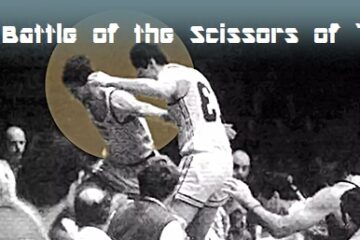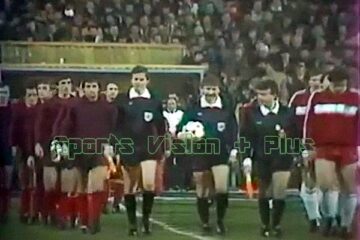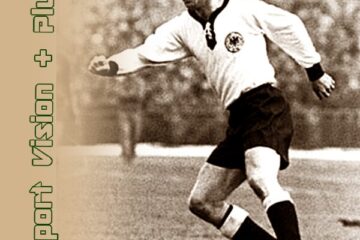1982 in Tokyo, when Penarol reached its peak as World Club Cup winners over Aston Vila!
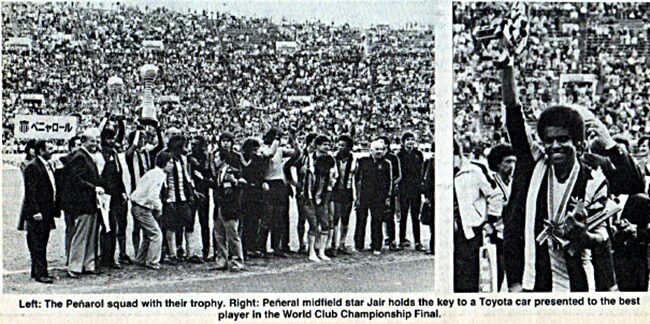
Prologue!
It is June 2025, and we are in the atmosphere of the development of a new event, as far as the most famous clubs of the time are concerned. More precisely, the system of an event that has been taking place since 2000 has been changed, namely the FIFA Intercontinental Cup, now taking place for the first time with a similar system to the FIFA World Cup in the rank of National teams.
In fact, the FIFA Intercontinental Cup is the successor of the Europe-South America Intercontinental Cup created in 1960 (until 2004), which was held with a single final between the winning club of the Champions Cup in Europe and the “Libertadores” Cup in Latin America.
Once upon a time, there were heated and fierce challenges, between the clubs of the two continents always rivals in football, challenges which have sometimes turned into violence.
From a long list of these cases of violence, we can mention some of them, such as that match of 1967 between the “Racing” Club of Argentina and Celtic of Scotland.
A year later, 1968, Manchester United vs Estudiantes of Argentina . 1969, in the “Bombonera” Estudiantes vs Milan, where Nestor Combin, an Argentine who played for Milan, was called a “traitor” by the Argentine fans and was left bloodied and unconscious after a brutal series agains the Estudiantes players who had lost the first match at San Siro 3-0!
We will talk about the violence and cases of this nature that these finals carried in another separate article.
From the first edition in 1960, until 1979, the International Cup for Clubs was held in two finals, while from 1980, the two finalist clubs, due to the violence that was being practiced, would meet in a neutral place, precisely in Tokyo, and the Cup would be named “FIFA International “Toyota Cup”, the precursor to the trophy that after 2004 would be called “FIFA Club World Cup” and that would be held with 6 clubs, champions of 5 continents, to come to this 2025 edition, of the exclusive system with 32 clubs divided into different groups, held in USA, similar to that of FIFA “World Cup”
1
1982, Penarol is the winner of FIFA Intercontinental Cup!
Chaos but Uruguay produces team of the year!
Out of the chaos of Uruguayan soccer sidelined from the last two World Cup finals (1978,1982) suffering from an acute financial crisis because of low gates caused by lack of interest and a poor standard because many leading players have been sold abroad… comes South America’s team of the year-Peñarol
The Montevideo club, one of the oldest in South America and an almost regular contender in the Libertadores Cup, has a long history of success, but with the decline of Uraguayan soccer in the 70s Peñarol also slipped out of the international scene although it continued to win titles regularly at home.
Their numerous fans had been reared on better things, but few of them could believe their ears when they heard that club president Washington Cataldi was bringing back their former leading scorer, Fernando Morena, in the midst of their financial troubles, paying Spain’s Valencia over a a million dollars for him in lengthy instalments still not completed and the player $15,000 a month.
This made Morena already in veteran stage at 31 not only by far the costliest player in Uruguay, but also by far the biggest earner…… but perhaps it was the spark that Peñarol needed to start on the way the top, although they had to reduce their playing and coaching staff to be able to pay Morena at all.
The first thing Morena did at Peñarol was to insist that they signed a new coach and he picked him- 67-year-old Hugo Bagnulo who had once been: in charge of the national team and who was well known for getting the best out of his players. Bagnulo, working with a small but mostly experienced staff of 20 players, rebuilt the team in his classical style – a safe goalkeeper, a hard- two destructive tight defence, midfielders prepared to work hard and three intelligent forwards.
The results soon came, although Peñarol could never be complemented on playing pretty soccer. Now Bagnulo has Gustavo Fernandez who was Uruguay’s third choice goalkeeper during the 1981 “Mundialito” in Montevideo, is very safe and expert at cutting out centres. He did not let a goal through in Peñarol’s first five Libertadores Cup games last year- against tough Brazilian opposition-until their semi-final place was assured.
In defense there is Diogo, the only flank defender who moves up well in attack and he has played some outstanding games recently; Olivera, a veteran international who is slowing down in the centre of defense, but makes up for it with experience and good positioning, as well as good heading – also in the opposing goal area after corners or free- kicks.
Guttierez, the other first choice central defender who is also good in the air, safe and fast and Morales, another veteran international who is slowing down, defends his flank very well, but does not go up much now.
The first choice halves are Saralegui who is more defensive (and destructive), stops up one side of the field, runs a lot and has a good understanding with Diogo, Bossio, the team’s outstanding newcomer (a junior international) who does the same as Seralegui on the other side.
He never seems to tire in spite of covering a lot of ground in defence, but hardly ever moves up: Jair, a Brazilian from Internacional of Puerto Alegre, does not mark anybody and waits for the ball to come to him, but he is dangerous when he has it with his creative flair, precision passing, bursts of speed and he starts most of the moves and takes the free-kicks which have to be watched. He has Zico’s knack of hitting curving balls to deceive defensive walls and goalkeepers from any angle.
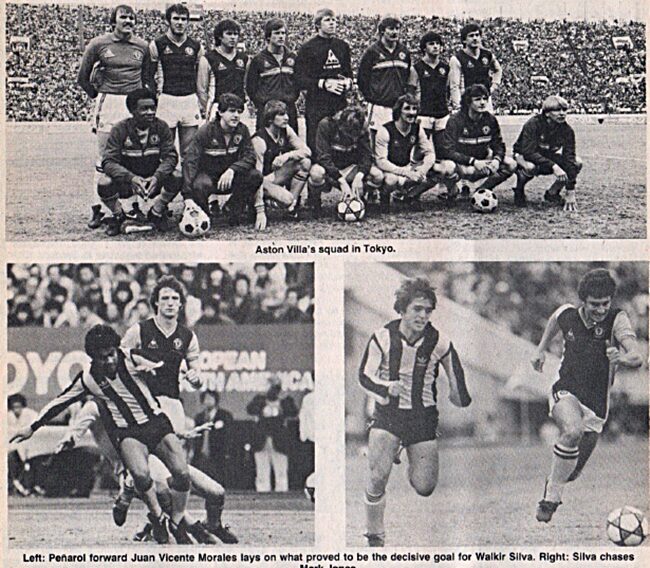
In front there is Vargas, a classical winger for fast counter-attacks and a scorer good with his head; Morena, a veteran international from the 1974 World Cup, a classical center forward who has often been blamed for not going into the area enough, but when he drops back he is more difficult to mark with the the result that he was again this season’s scorer in the first division and the Libertadores Cup he scored the only goal the final in the last minute: Ramos, the tricky right-winger and star of Uruguay’s “Mundialito” winning team, but injury has sidelined him a lot and he has an experienced reserve in Silva.
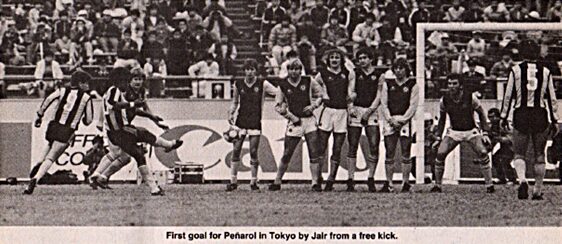
And they had no easy passage in this season’s Libertadores Cup, having to knock out Brazil’s Gremio and star-studded Sao Paulo in the first-round group, then another Brazilian star team, title holders Flamengo, the semi-finals and tough Cobreloa of Chile-the unluckiest team on the continent in the final to make them South America’s top club.
2. A little history….
On September 28, 1891, a group of 118 employees of the British-owned Central Uruguay Railway founded the Central Uruguay Railway Cricket Club, but as the railway’s central office and the club was situated in the Montevideo district of Peñarol, it soon became known by that name.
The club’s first president was an Englishman, Frank Hudson, and its first membership list was made up of 74 Englishmen, 45 Uruguayans and one German. Their first game of soccer was played the following year against the British School (Montevideo). Peñarol won 2-0 and from then success never left them.
In 1900, Peñarol and three other clubs- Albion FC, Uruguay FC and Deutscher FK -formed the Uruguayan FA and immediately the first championship was played which Peñarol won unbeaten.
They retained the title the following year, but then their external rivals, Nacional, won it for two years. In fact these two clubs have won practically all the honours in Uruguay from the start right up to the present day. Of the 78 first division championships held so far, Peñarol has won 36 and Nacional 33, but their dominance has been even more complete since the introduction of professional soccer in 1933 since when Peñarol has won 25 and Nacional 22 of the 48 titles.
In 1905 Peñarol managed to win the title without conceding a goal. The club, which has always worn the same black and yellow striped shirts, inaugurated its stadium on the outskirts of Montevideo in 1916, but this is now used as a training camp, while all their games are played at the 75,000-capacity “Centenario” stadium which is shared with Nacional.
The year 1949 was another milestone of success for the club as they won their 26 league matches. Such famous players as Obdulio Varela, Alcides Ghiggia, Eduardo Hohberg, Omar Miguez, “Pepe” Schiafino, Roque Maspoli and Victor Rodriguez Andrade played in that brilliant team and a year later all except Hohberg (an Argentine) were to help Uruguay win the World Cup in Rio de Janeiro.
Peñarol also supplied four players for Uruguay’s previous World Cup win in the first tournament in Montevideo 20 years earlier.
Peñarol’s best run was from 1958 to 1962 when they won the Uruguayan title five years in succession. Their worst period was back in the amateur days when they did not win a title for six years from 1911 to 1918. Peñarol’s domestic success must however be kept in perspective, because apart from them and Nacional there are no other strong clubs in Uruguay, but at the same time they have also been very successful in international competition.
Partly to earn money to pay their expensive playing staff and partly to keep abreast of the latest tactics, Peñarol have made frequent trips abroad although they have been less frequent in the last few years. During many seasons they used to play as many matches abroad as at home.
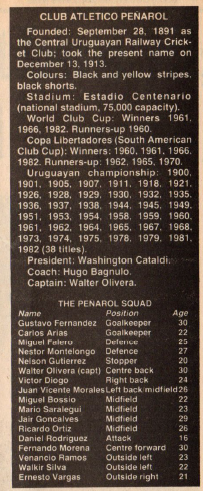 PART OF LIBERTADORES CUP HISTORY
PART OF LIBERTADORES CUP HISTORY
Continuing their series of “firsts”, Peñarol was the first club to put its name on the Libertadores Cup (the South American club championship) in 1960, winning that inaugural tournament undefeated.
They failed to win the first Inter Continental Cup (Europe-South America Cup) when they lost the challenge matches for the “world title” against European Cup winners Real Madrid that year, but they retained the South American trophy the following year and this time added the Inter-Continental Cup to their trophies by beating Benfica after three games.
Goncalves (centre-half), Cubilla, Spencer Ecuadorian who is all-time leading scorer in the Libertadores Cup), Sasia, Joya and Ledesma lined up in that excellent Peñarol team.
In 1966, Peñarol won the Libertadores Cup for the third time in a controversial final against Argentina’s River Plate, winning the play-off 4-2 in extra time.
Penarol, the Uruguayan club which has participated in almost every Libertadores Cup and won the trophy when it was first played for in 1960, took it for the fourth time this season… a minute before the end with the only goal scored in the two-leg final against Chile’s Cobreloa.
Nothing great was expected from the finals between these two clubs who both thrive on tight defense, stopping the opposition from building up attacks and creating their own danger mostly from opportune counterattacks with little build- up and everything went pretty much according to plan.
When Cobreloa managed to hold Peñarol 0-0 in Montevideo in the first leg, it was expected that the club which only joined the Chilean championship (second division) in 1977, gained promotion the same year, were first division vice-champions in 1978 and champions the next year and reached the Libertadores Cup final in 1981, would win the trophy for the first time.
But Peñarol, playing exactly the same type of away game for a draw, had a man with the vast experience of their veteran striker Fernando Morena, scorer of most of their goals who passed the 600 goals mark this season, who took one of his team’s few chances to score in the last minute.
Cobreloa, who drew five of their six away games in the Cup, surprised Penarol a bit in the away leg in Montevideo by fighting for midfield domination from the start to stop the Uruguayan team’s attack build-up instead of just packing their de- fence.
The Chilean halves managed to cut off Peñarol’s organiser, the Brazilian Jair who could only show his exquisite touches occasionally. Winger Silva missed Penarol’s best chance when alone in front of goal after 23 minutes, but Cobreloa goalkeeper Wirth somehow managed to block his shot.
Peñarol were much more on top in the second half, but they battered into the tight Chilean defense to no avail as Cobreloa – clearly showing they would be happy with a draw-only occasionally launched feeble counter attacks which lacked danger.
Cobreloa went into all-out attack from the start in the second leg in Santiago-not quite their type of game and they did have the cautious Peñarol defense in difficulties on a couple of occasions, but Fernandez made outstanding saves from Ruben Gomez and Merello within a couple of minutes.
Peñarol’s counterattack did not function in the first half as Jair was again cut off from his forwards, but a tiring Cobreloa had their own attacks cut off in the second half and relied more and more on high balls into the box which brought little result.
Peñarol dominated for the last 25 minutes and had their best chance after 35 when Wirth could only parry out a shot from Ramos and Rodriguez failed to score from the rebound in front of any empty goal. In the final minutes Cobreloa attacked desperately for the winner, for once leaving their defence under-manned while Peñarol left their most dangerous strikers, Ramos and Morena, up and they created danger every time they touched the ball.
In the final minute a defensive clearance from Diogo found Ramos who passed to Morena and the latter, tried a long shot on the run which found the comer of the net. There was no time left for Cobreloa even to attempt a fight-back.
Peñarol made the traditional tour with the cup around the field under a shower of bottles, stones and other objects from some 65,000 angry Chilean fans and amid the cheers of about 5,000 Uruguayans who made the journey to Santiago.
Out- side the stadium afterwards, things became nastier when home fans smashed up shop windows and attacked police who tried to stop them. In Montevideo meanwhile, thousands of cheering fans took to the streets, but things also became nasty when the cheering turned to chants against the government and ended in fighting with police and 300 arrests.
_____________________
Sports vision + Plus / Champions Hour in activity since 2013
References: World Soccer / February 1983 / Pages 10-13 by Eric Weil
Discover more from Sports Vision +
Subscribe to get the latest posts sent to your email.


